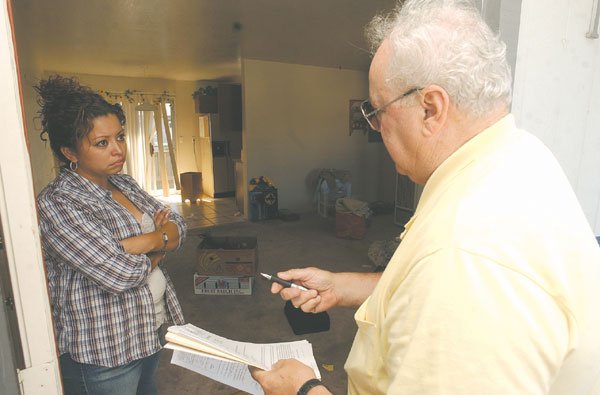Eviction in the South Valley isn’t always pleasant, but it
happens
The landlord and the locksmith are already at the house when Marshal Robert Scattini pulls up to the three-bedroom home on Jacqueline Drive in Hollister. He was here last week, posting the sign that now flutters in the breeze on the front door, warning the home’s tenant of her impending eviction.
Today, Scattini is here to inspect the home and finalize the notice while every lock in the home is changed.
Evictions aren’t a pretty business. They’re emotional and confrontational, and sometimes dangerous, but someone has to do them. In some counties, special eviction services exist, but in most areas, the duty falls to the county marshal.
In San Benito County, Scattini executes an average of 30 evictions a month.
“I posted four yesterday,” said Scattini. “Some people are very emotional, but it’s really especially stressful for single parents with kids. I feel sorry for the people – people with kids, people with husbands and wives, young and old. The kids are frightened – scared to death. You can see it in their face.”
Evictions are part of the job, said Scattini, but it doesn’t mean he’s always comfortable doing them.
“I’ll bend over backwards to try and make sure someone has a place to go,” said Scattini. “One time I gave a family money to stay in a hotel for a couple of weeks. They had nowhere and the church couldn’t help just then. I don’t bend the law, but I’ll stretch it to the limit.”
At the home on Jacqueline, Scattini walks up the drive, past the browned lawn and dying flowers, and into a home that has been deserted. He notes that not much appears to have been packed. Boxed and canned food is still neatly lined up in the cupboards. Dressers are still full of clothing and bathrooms are still stocked with toiletries.
Landlord Janet Roberts wanders the home in open-mouthed disbelief. Though evictions are necessary “all too often,” what she finds inside the home is still a surprise.
“It’s an epidemic lately,” said Roberts, gesturing at the former tenant’s belongings. Then, turning to Scattini, “Do you think it’s drugs?”
A renter was living here with her children, but she’s gone now, leaving behind items like her hair dryer and family pictures in their frames.
On the nightstand next to the renter’s bed, Scattini finds something else she left behind: a 625,000-volt tazer. It’s stronger than the standard-issue tazers carried by police and sheriff’s officers in the area. That, and it’s illegal for a civilian to possess in California.
“There’s always the element of some danger,” said Scattini, pointing to the case of JoAnna Jones, a 53-year-old New York woman who became so enraged during her eviction that she set marshal Erskine Bryce, 66, on fire, burning him to death.
Still, Scattini himself has only had to call for police aid once. Nearly six years ago, he arrived at a home to serve a restraining order and eviction notice on a man’s wife, only to find the couple watching television, and the man tenderly putting his arm around her.
The woman, it turned out, had no idea her husband was planning on a divorce and fainted soon after Scattini’s arrival. When she came to, she was so hysterical, he decided to call for police and ambulance service before she blacked out again.
Most evictions are a smooth, if long process, though. When a tenant does not pay the rent, a landlord must file a three-day notice to pay or quit the residence. If the resident does pay the rent during that time, landlords bent on getting rid of a tenant can still file a 30- or 60-day notice of eviction depending on how long the tenant has lived in the home or apartment. If the tenant doesn’t pay by the end of the three-day time limit, the landlord can immediately file a complaint with the county court to which the resident has five days to respond, said Scattini.
Residents who do not respond to the complaint against them may receive a notice of eviction as soon as the fifth day passes, but those who do respond have the opportunity to have their cases heard in court about three weeks later, said Scattini.
“The California Rural Assistance League will help some of the tenants, and some of the landlords have attorneys, but you don’t have to,” said Scattini.
The judge hears both sides and decides the terms of the eviction, including forgiveness of back rent or rental extensions if there is evidence of housing violations, said Scattini.
“One of the craziest things I ever saw … this gal comes into court with two brown bags,” said Scattini. “When it was her turn to speak, she didn’t say anything. She just got up, unrolled the tops of the bags and pulled out two big gallon-sized pickle jars full of dead rats. When the landlord’s attorney saw that, he made a deal with the defendant and the judge as fast as he could.”
Once the eviction process has been approved, the county marshal posts a one-week notice of eviction on the tenant’s door, then returns to see that the tenant is really out the next week.
Sometimes when he arrives, tenants haven’t packed their things at all. Other times, the home is left in disarray with walls vandalized, months-worth of trash piled up and dirt ground into the carpets. That’s when landlords cry.
“I’ve had people just bawl their eyes out,” said Scattini. “This was the house they lived in and the house they put work into. Here, they let someone move in and six months later, it’s torn to shreds.”
A rental’s road to recovery cannot always begin right away. The tenant’s things must be kept safe for 15 days, so most land owners leave them locked in the house. After that, any lot with a total value of $300 or more must be auctioned off at a public sale, the proceeds of which go to pay off the tenant’s debts.
Any additional money is returned to the tenant, said Scattini, though there’s usually none left.
Still, the first step in a return to normality for the landowner comes the day of the eviction. As tenants leave, the locks are changed behind them by technicians like Casey Long of Muenzer’s Locksmiths in Hollister.
Long works an average of two evictions per month, spending roughly half an hour removing old door and garage locks and installing new ones.
“Sometimes the tenant loses the key and the owner doesn’t have one, so I kind of have to pick my way in,” said Long. “I’ll go through and do what the owner asks. For Mrs. Roberts, I always check windows, but not everyone asks for that.”
Long works seem to be cyclical, he said.
“It seems like they show up more in February, right after Christmas when people are having trouble paying off the bills,” Long said.
For evicted tenants, a small measure of help is usually available through churches and charitable organizations such as the Salvation Army, but many times, it’s not enough, said Scattini.
“Most of these people who can’t pay their rent may not have any money, even for food,” said Scattini. “We can go overseas and help people in foreign countries with food and shelter, but we can’t help our own it seems like.”












